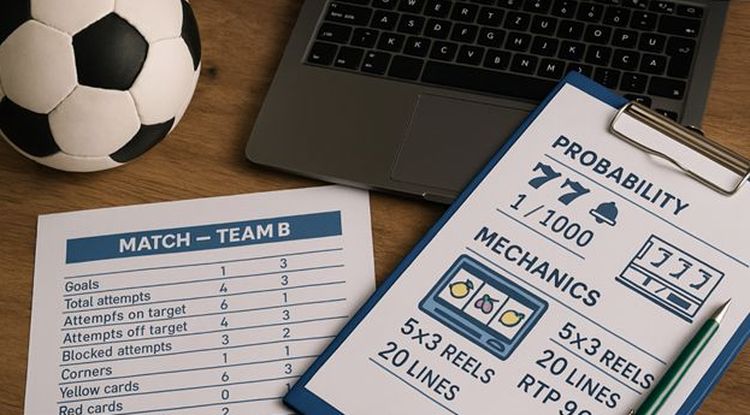
If you follow football closely, or even if you just check scores now and then, you might notice analysts picking over heaps of data: who’s moving the ball, who actually finishes chances, how teams handle setbacks. Those numbers, the ones that show up as stats on your screen, do a lot more than just fill up space. Sometimes they pick apart performances so sharply that even the teams themselves adjust based on what they reveal.
Meanwhile, over in the digital sphere, online slots use a completely different mathematical logic, dominant by random chance, not match play. It’s all rooted in probabilities, sure, but the kind you get from a spreadsheet of passes isn’t anything like what happens on a spinning reel.
In football, a clever model might spot a likely result, but then, with slots, you’re staring at randomness fueled by code, not player skill or tactics. Everyone, fan or player, ends up facing odds that aren’t really “equal”, and what counts as an advantage shifts wildly from one arena to the other.
Football Match Statistics
Each week, squads of coaches and data analysts, not to mention fans scrolling Twitter, swim around in massive pools of stats. Some metrics, say, Expected Goals (xG) or even just old-fashioned shots on target, reveal plenty about who’s really pressing the advantage. Goal difference serves as a sort of north star: teams at the top, like those Premier League giants in 2022/23 with goal differences smashing past +40, turn that number into a brag.
But then, with uneven schedules scattered everywhere, Points Per Game steps in and supposedly evens things out, maybe showing who’s not just having lucky streaks. Real-time models are another beast. Data models pull in things like possession or field control, then try to spit out live probabilities, though the number jumps around, especially after something wild like a red card or a late sub.
These models claim shifts of 15% or more in their projections, but, honestly, the chaos of a sudden tactical turn can surprise them. In the moment, these details are less about writing history and more about what a manager patches up before the next kickoff.
Slot Game Probability and Mechanics
The whole data circus that surrounds football? Practically irrelevant when it comes to slots. Each spin is set on its own isolated timeline, driven by a Random Number Generator (RNG) that doesn’t remember, doesn’t care. Probability becomes the only language that matters.
A classic video slot, imagine one with five reels, each lined with 30 symbols, quietly generates over 24 million possible results every single spin. And none of those results owe anything to what came before. Return to Player (RTP) percentages give some idea of what players might see back, over thousands or even millions of rounds. Sometimes it clocks in at 94%, sometimes a little higher, up to 97%.
Remember, that’s a long-term average, not a promise for your next round. Volatility, or variance, adds extra spice: you could spin for ages and lose, or suddenly see a result that no spreadsheet could anticipate. There is a paytable, and you could pore over the numbers there if you cared to, but the fact stays the same, outcomes flicker in totally independent bursts. No tip or system affects it. That’s just how the game is built.
Comparing Statistical Models
While both football and slot games throw around the word “probability,” they don’t mean anywhere near the same thing. With football, there’s talk of Poisson Distributions, a way, if you squint, of guessing how many goals pop up in a match, based on everything from old goal tallies to current form. Bookmakers lean hard on databases stuffed with old results, guided by Monte Carlo methods that run matches over and over again, all in software, to adjust their odds. But in slots? Probability is as narrow as it gets: reels, symbols, and a fixed random seed inside the RNG.
No history. No context. The past, for slots, actually has no future. In football circles, fans chatter over Elo ratings, arguing about whether a new coach’s arrival should cause a jump or a drop. Slot players know, or ought to anyway, that the “house edge” isn’t going to budge because of a hunch. The gap between tweaking a spreadsheet and spinning a reel stays wide, and probably always will.
The Human Element and Data Limits
However much we trust our graphs and stats, outcomes don’t always play along. Football numbers can reveal consistent patterns, certain teams really do fire off more chances or limit shots better, but then there’s always that match nobody predicted. Leicester’s wild title run in 2015/16 springs to mind, odds so long they more or less broke the model. The messiness of morale, weather, even crowd energy (if you believe in that sort of thing), these drift outside what numbers alone can pin down.
Back in the world of slots, it all appears tightly regulated by equations. Still, psychology has its fingerprints everywhere. Players sometimes chase “hot streaks,” ignoring all warning signs and the underlying math that tells them each spin is completely isolated. Numbers whisper one thing, but our brains love a little superstition, or maybe just stubborn hope. In both worlds, something unscripted manages to slip through.
Responsible Gaming and Informed Decisions
Stats, models, odds, they can all help frame expectations, but they tend to gloss over the real unpredictability in both football and slots. Maybe the safest approach, if you ask around, isn’t so much about hunting for certainties but about recognizing limits and triggers: set some mental or financial guardrails, be aware of where skill leaves off and luck takes over.
The best advice floating around? Grab onto what helps you stay in control, whether it’s shutting off after a bad run or just refusing to spiral on a risky hunch. There’s always excitement, possibilities, sometimes disappointment too, but seeking guarantees is, well, probably the surest way to come up empty.








